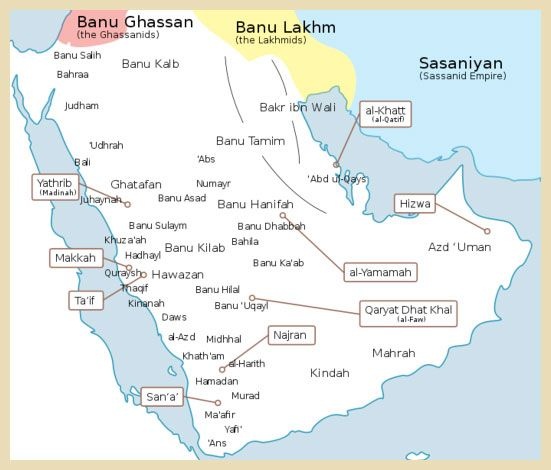
Pre-Islamic Religion on the Arabian Peninsula
The peoples of Arabia were predominately polytheistic, and Mecca was the place of their most important sanctuary, the Ka’ba (see below). Its ancient origins are unknown but, since all accessible deities were represented there, it was a place of annual pilgrimage for all tribes. At one time there were said to have been as many as three hundred and sixty idols in and around the Ka’ba. This, too, was under the control of the Quraysh, who wisely established a non-violent zone that was Haram (sacred, forbidden), radiating for twenty miles around the sanctuary, and made Mecca a place where any tribe could enter without fear and where they were free to practice both religion and commerce.

The Ka’ba was the most important holy place in Arabia even in pre-Islamic times; it contained hundreds of idols representing Arabian tribal gods and other religious figures, including Abraham, Jesus and Mary. It is a massive cube believed to have been built by the Prophet Abraham – the ancestor to the Arabs through his first son Ishmael – and dedicated to al-Lah (The God who is the same God worshipped by the Jews and Christians); it stands in the centre of the Sanctuary in the heart of Mecca. Embedded in the Ka’ba’s granite matrix is the famous Black Stone, which tradition says was originally cast down from Heaven as a sign for Adam.
The Zam-Zam holy well is nearby and is believed to have quenched the thirst of Hagar and her child, Ishmael, in the wilderness. (Genesis 21:19). Arabs from all over the peninsula made an annual pilgrimage to Mecca, performing traditional rites over a period of several days. Mohammad eventually destroyed all the idols in and around the Ka’ba, and re-dedicated it to the One God, Allah, and the annual pilgrimage became the Hajj, the rite and duty of all Believers.
“The usual form of worship is for pilgrims to circle the Ka’ba seven times at a trot and then to drink from the holy spring. This rite seems to have a straightforward interpretation, with the square Ka’ba symbolizing the four corners of the earth which is circled seven times, just like the seven planets (or spheres of heaven) which were believed to circle the earth. We still live today in a yearly calendar ordered by these ancient beliefs, from the names and numbers of our days of the week, to the four weeks that form our lunar months and the stellar signs of the zodiacs.” (The Prophet Muhammad: A Biography, Barnaby Rogerson.)



